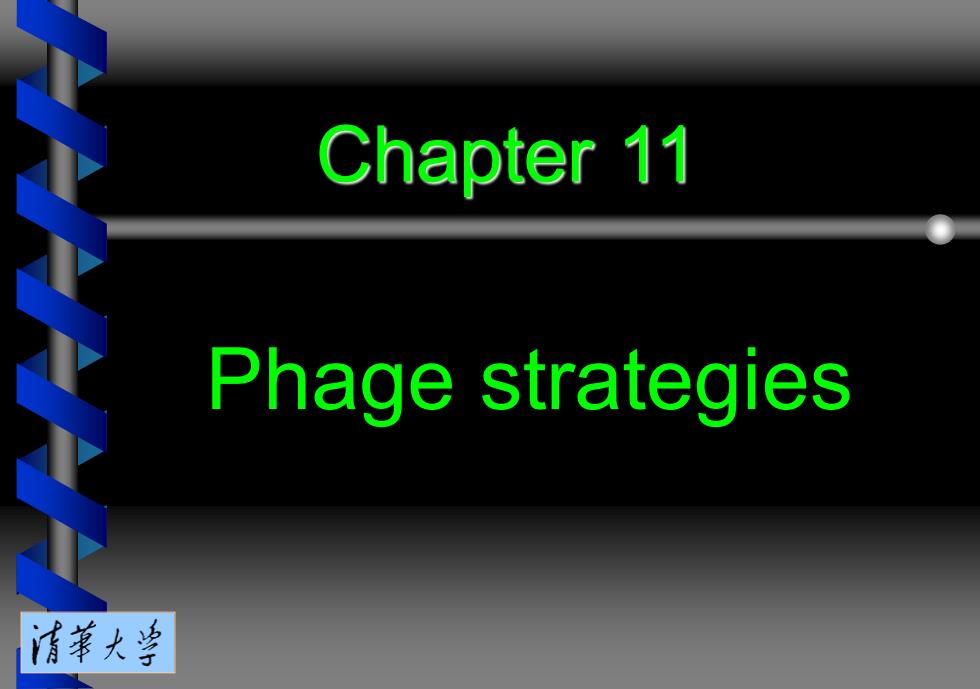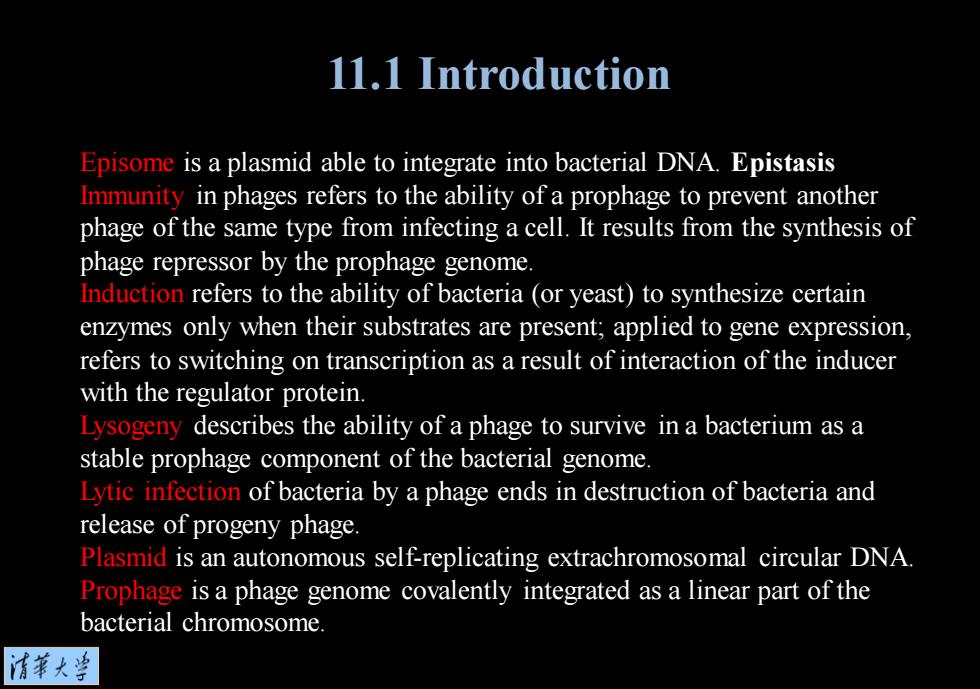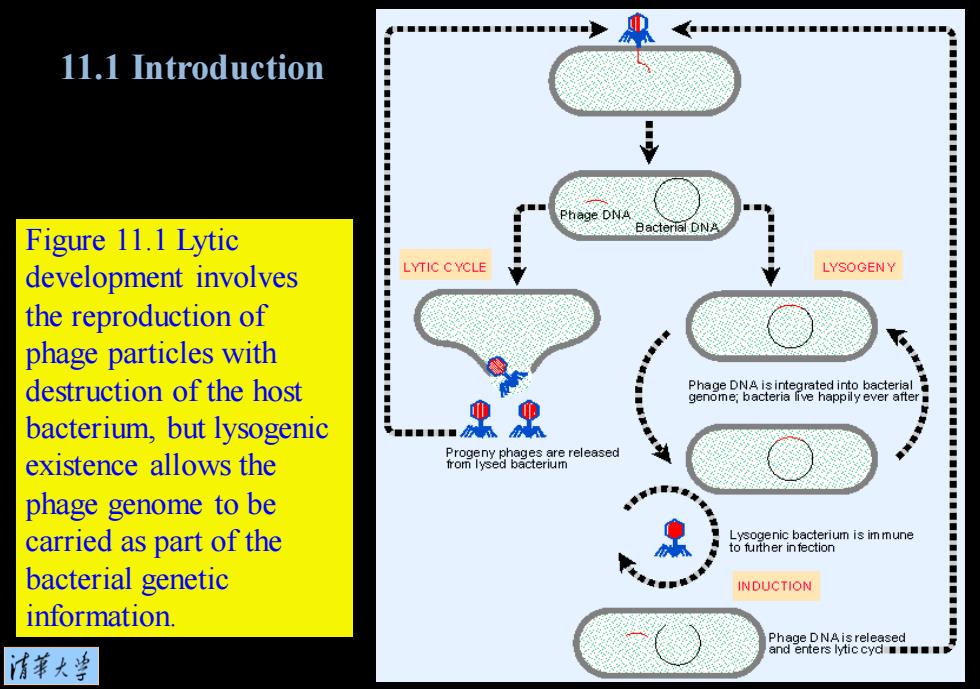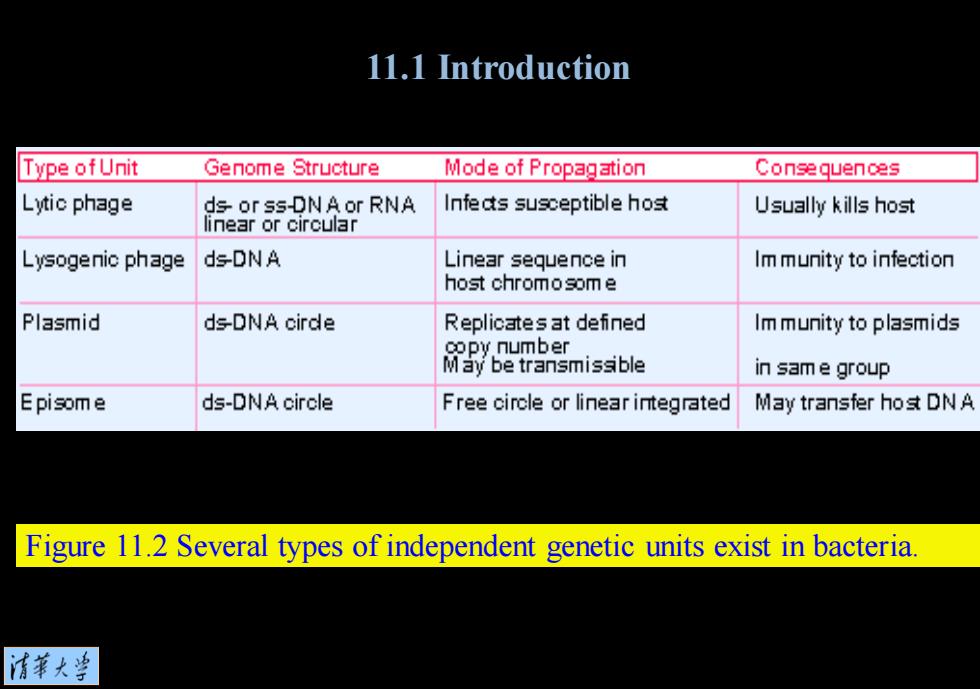
Chapter 11 Phage strategies 清革大当
Chapter 11 Phage strategies

11.1 Introduction 11.2 Lytic development is divided into two periods 11.3 Lytic development is controlled by a cascade 11.4 Functional clustering in phages T7 and T4 11.5 Lambda immediate early and delayed genes are needed for both lysogeny and the lytic cycle 11.6 The lytic cycle depends on antitermination 11.7 Lysogeny is maintained by repressor protein 11.8 Repressor maintains an autogenous circuit 11.9 The repressor and its operators define the immunity region 11.10 The DNA-binding form ofrepressor is a dimer 11.11 Repressor uses a helix-turn-helix motif to bind DNA 11.12 Repressor dimers bind cooperatively to the operator 11.13 Repressor at OR2 interacts with RNA polymerase at PRM 11.14 The cIl and cIll genes are needed to establish lysogeny 11.15 PRE is a poor promoter that requires cll protein 11.16 Lysogeny requires several events 11.17The cro repressor is needed for lytic infection 11.18 What determines the balance between lysogenic and the lytic cycle? 情菜大学
11.1 Introduction 11.2 Lytic development is divided into two periods 11.3 Lytic development is controlled by a cascade 11.4 Functional clustering in phages T7 and T4 11.5 Lambda immediate early and delayed genes are needed for both lysogeny and the lytic cycle 11.6 The lytic cycle depends on antitermination 11.7 Lysogeny is maintained by repressor protein 11.8 Repressor maintains an autogenous circuit 11.9 The repressor and its operators define the immunity region 11.10 The DNA-binding form of repressor is a dimer 11.11 Repressor uses a helix-turn-helix motif to bind DNA 11.12 Repressor dimers bind cooperatively to the operator 11.13 Repressor at OR2 interacts with RNA polymerase at PRM 11.14 The cII and cIII genes are needed to establish lysogeny 11.15 PRE is a poor promoter that requires cII protein 11.16 Lysogeny requires several events 11.17 The cro repressor is needed for lytic infection 11.18 What determines the balance between lysogenic and the lytic cycle?

11.1 Introduction Episome is a plasmid able to integrate into bacterial DNA.Epistasis Immunity in phages refers to the ability of a prophage to prevent another phage of the same type from infecting a cell.It results from the synthesis of phage repressor by the prophage genome. Induction refers to the ability of bacteria (or yeast)to synthesize certain enzymes only when their substrates are present;applied to gene expression, refers to switching on transcription as a result of interaction of the inducer with the regulator protein. Lysogeny describes the ability of a phage to survive in a bacterium as a stable prophage component of the bacterial genome. Lytic infection of bacteria by a phage ends in destruction of bacteria and release of progeny phage. Plasmid is an autonomous self-replicating extrachromosomal circular DNA Prophage is a phage genome covalently integrated as a linear part of the bacterial chromosome 清菜大当
Episome is a plasmid able to integrate into bacterial DNA. Epistasis Immunity in phages refers to the ability of a prophage to prevent another phage of the same type from infecting a cell. It results from the synthesis of phage repressor by the prophage genome. Induction refers to the ability of bacteria (or yeast) to synthesize certain enzymes only when their substrates are present; applied to gene expression, refers to switching on transcription as a result of interaction of the inducer with the regulator protein. Lysogeny describes the ability of a phage to survive in a bacterium as a stable prophage component of the bacterial genome. Lytic infection of bacteria by a phage ends in destruction of bacteria and release of progeny phage. Plasmid is an autonomous self-replicating extrachromosomal circular DNA. Prophage is a phage genome covalently integrated as a linear part of the bacterial chromosome. 11.1 Introduction

11.1 Introduction Figure 11.1 Lytic development involves LYTIC CYCLE 江” LYSOGEN¥ the reproduction of phage particles with destruction of the host cn ve hpye Phage DNA is integrated into bacterial bacterium,but lysogenic ■■■■■■ existence allows the 6R%838,品released phage genome to be carried as part of the Lysogenic bacterium is im mune to further in fection bacterial genetic INDUCTION information. 清菜大当
Figure 11.1 Lytic development involves the reproduction of phage particles with destruction of the host bacterium, but lysogenic existence allows the phage genome to be carried as part of the bacterial genetic information. 11.1 Introduction

11.1 Introduction Type ofUnit Genome Structure Mode of Propagation Consequences Lytic phage ds or ss-DNA or RNA Infe ats susceptible host Usually kills hos式 linear or circular Lysogenic phage ds-DNA Linear sequence in Im munity to infection host chromosome Plasmid ds-DNA cirde Replicates at defined Im munity to plasmids oopy number May be transmissible in sam e group Episome ds-DNA circle Free circle or linear integrated May transfer ho式DNA Figure 11.2 Several types of independent genetic units exist in bacteria. 清菜大兰
Figure 11.2 Several types of independent genetic units exist in bacteria. 11.1 Introduction